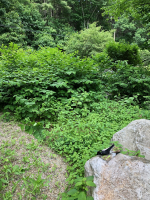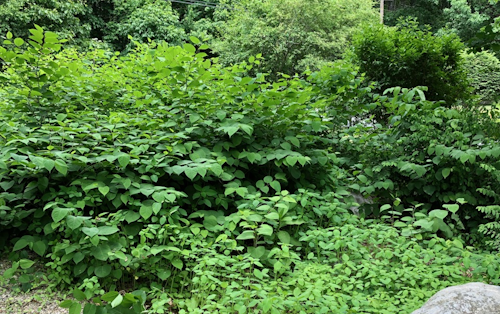Above: A thriving patch of invasive weeds in Southborough. (photo contributed by SOLF — clearly taken in a warmer season!)
[This post is part of a special guest series focused on appreciating nature in Southborough, contributed by the Southborough Open Land Foundation (SOLF), a non-profit dedicated to preserving and stewarding natural resources here in town.]
Many stories have a villain. In nature, invasive species are just that – the aggressive, successful new citizens to unprepared ecosystems. Though anything alive can fall into this category, non-native plants can blow in the wind, accidentally ride in the grooves of a boot, hull of a boat or arrive as a specially-ordered, ornamental for your garden (for example, one UMass Amherst study of tracked 55% of U.S. plant “invasions” back to garden nurseries!). Either way, if it gains a foothold, it can pose real problems for our yards and open spaces. Here, we’ll talk about one invasive variety of knotweed.

Though the native herbs, insects and soils of Japan largely keep their growth in check, this knotweed variation (Fallopia japonica or Polygonum cuspidatum) has thrived across Massachusetts and Southborough. The bamboo-like stem known as Japanese knotweed can reach heights of 10 ft in the early spring and survive our harsh winters using tolerant, underground root systems whose core can be the size of a basketball. Incredibly, root segments as small as 1 cm in length can regrow to full height! As a result, the plants are remarkably competitive and have changed the local landscape in recent years by flooding open spaces with their heart-shaped leaves and spreading fast using clumps of yellow seeds. They eventually push out local species and disrupt the patchwork of flowers, pollination sites and potential homes and food sources for so many creatures, including us! A recent study by Holy Cross College found that 1 in 3 plant species found in Worcester County was non-native, while a related Boston University study on a Boston woodland found it was gaining exotic species at a rate of one every 5 years.
To be clear, the impact of Japanese knotweed on our community and open spaces has been profound and complicated the lives of local bees, butterflies, birds and other animal species. Locals, like myself, have spent countless hours digging up hundreds of pounds of stems and roots only to watch the persistent rhizomes lean on their sugar-rich roots and return (albeit with fewer, much shorter, depleted stems!). In fact, like our local lead paint, homeowners in England are prevented from flipping their property if knotweed stands aren’t removed! Control is labor intensive and can benefit from strategic, responsible dabs of select herbicides to newly cut stems, yet studies suggest its use can threaten amphibians and vulnerable species, especially near wetlands.
However, we should conclude with another view. According to botanists and chefs alike, all parts of the plant, from root to shoot to stem, are edible and each offers a unique flavor – from leafy greens to crunchy water chestnut to lemony rhubarbs. In fact, the concentration of resveratrol, a substance well documented to have anti-tumor, -inflammatory and anti-aging effects is very high in their roots. So perhaps large harvests and collaboration with local CSAs and herbal medicine practitioners is in order and could save your life!
Lastly, at what point does the invader become the native? Our backyards have changed over and over since the arrival of the first European settlers. And the settlers millennia before that. Another part of the BU study found that 22 exotic species have disappeared from Boston’s Middlesex fells since 1894, suggesting impending doom to those less-then-hearty visitors of New England soils, yet 36 new ones have come during the same period! That’s just how natural selection works in a changing world…what will the landscape of Southborough look like in future?
Have a photo or experience with non-natives and challenges removing them? Let us know!
Want to learn more about SOLF, or volunteer or donate? Check out our site, we’d love to hear from you.
Lawrence Spezzano, Trustee
SOLF – Southborough Open Land Foundation



“Many stories have a villain.” In this case it is the feral Primates. The invasive species from Hell.
I’m not sure which of the many plants in the photos is Japanese knotwood. Could someone please clarify this?
Anne Jones
The knotweed has the heart shaped leaves. You can find other images online. SOLF did contribute a larger photo but that doesn’t work well on the blog’s format. I just created a different version graying out the plants that I believe aren’t Japanese Knotweed. You can see that by clicking here.